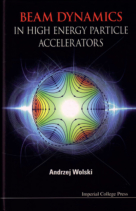By Andrzej Wolski
World Scientific
Hardback: £98
E-book: £74

This book by Andrzej Wolski is not a general textbook but, rather, a theoretical monograph on some of the basic physics of particle accelerators, with a strong emphasis on what can be treated analytically. It is decidedly not an introduction to accelerators. Indeed it contains no description, photo or diagram of what a particle accelerator looks like, no list of numerical parameters, nor any indication of what purposes such a device might serve. I could find no mention of the name, or energy, of any past or present accelerator. The unit of MeV first appears in relation to the spacing of spin resonances. I wonder whether the author consciously sought to imbue his work with a whiff of Whittaker’s treatise? No criticism intended – I rather admire his temerity – just make sure that you have some background before tackling this 590-page opus.
The first two words of the title are key to its coverage: beam dynamics is treated as an application of classical Hamiltonian mechanics and electrodynamics. These are the explicit prerequisites. Among existing books, those of S Y Lee (a little shorter and denser) and H Wiedemann (almost twice as long), are pitched at a similar level, but structured as textbooks with exercises and more applications.
I liked chapter one, a useful description of the electromagnetic fields in magnets and RF cavities that goes into more depth than most, and is careful to explain some key practical concepts that are sometimes taken for granted. On the other hand, there is no mention of how strong you can make those fields. Subsequent chapters cover thoroughly the well-trodden ground of linear single-particle dynamics and optics in the two transverse degrees of freedom, taking a Hamiltonian approach ab initio. I was a little disappointed in the perpetuation of an unfortunate choice of the canonical variables for longitudinal motion, first made in a well-known computer program in the 1980s. Perhaps it is as well to follow the crowd now, but subsequent Hamiltonians become messier than necessary, and there is some unnatural fudging around the dispersion function.
Unusually, but logically, longitudinal motion is treated in the context of a chapter on coupling, before the introduction of a formalism for full linear coupling. There is a standard discussion of synchrotron radiation (omitting the quantum lifetime) and low-emittance lattice modules for light sources. Nonlinear dynamics gets a great deal of attention, with discussions of the traditional topics of Lie transformations, canonical perturbation theory, symplectic integrators, nonlinear resonances, dynamic aperture and frequency map analysis. Practical results on linear perturbations are also worked in.
Like Lee and Wiedemann, Wolski says surprisingly little about colliders. There is no mention of low-beta collision optics, dispersion suppressors or separation schemes. A brief discussion of the head-on beam–beam effect and a passing mention of luminosity are appended to a more comprehensive discussion of single-beam space charge. Perhaps this reminds us that most accelerators are not colliders. There is a good derivation of the Touschek lifetime, but the standard results on intra-beam scattering (Piwinski, Bjorken–Mtingwa) are only quoted.
The final chapters cover wake-fields and impedances, and the collective instabilities they drive. The formal approach works well here, imposing order and clarity on what can be a confusing array of concepts and definitions. Several important beam- instability mechanisms are treated in detail.
The book seems relatively free of misprints (although there is a glaring one after equation 2.17). Overall, this is a recommendable addition to the literature, covering its topics clearly and thoroughly.





